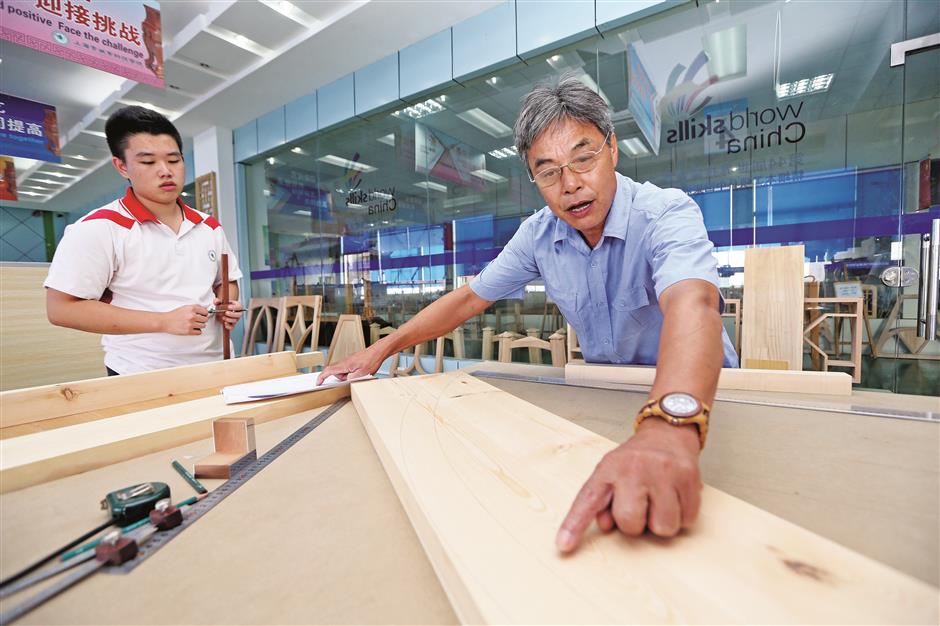A master and the art of woodcraft
Houses built with wood instead of bricks were more common place in ancient China. Windows had a wooden frame, rather than plastic or metal. Inside your house there would be a wooden table or a wooden bookshelf.
Shen Xueyun, a conventional carpenter in Songjiang, was one such carpenter who learned the old traditional ways of carpentry. Subsequently, he received several awards as a consequence and became a teacher at Shanghai City Science and Technology School.
Prior to the 44th WorldSkill Competition in Abu Dhabi last month, and as the coach of the Chinese carpentry team, he said: “I don’t have the best temperament with people outside of work but I’ve got a lot of patience with my students when teaching them the arts and crafts of carpentry.”
He was as good as his word because one of his disciples went on to triumph at the prestigious event.

Shen Xueyun inspects a mini wood house at Shanghai City Science and Technology School where he teaches traditional Chinese carpentry skills.
Student success
It is one of Shen’s finest achievements as a teacher, coaching a student, Zhang Jiahao, to a triumph at the 44th WorldSkill Competition. Zhang scooped a gold medal in the 2017 China International Skills Competition. This time he was a reserve for the competition.
Having won the titles of “Gold Medal Coach” and “Excellent Intensive Training Coach,” Shen was employed as the coach for the Chinese national team for the 44th WorldSkill Fine Wood Carpentry Category.
The master craftsman had spent over a dozen hours a day training the students in the run up to the competition. He tried to make out test questions that not only bridged the notional differences of the East and the West, but also matched the level of the students.
The competition required candidates to work for four days and complete two pieces of work within 22 hours. But prior to the competition, Shen set his students a task to finish the work within 10 hours, so they would feel more at ease when competing.
Carpentry has a long history in China, but it was the first time a Chinese carpentry team participated in a world competition. Without any experience to learn from, Shen drilled his students hard in preparation and even learned English, just in case there were any communication problems. All of the preparation and hard work became worthwhile after the success they enjoyed.

Shen coaches a student of carpentry.
The apprentice craftsman
When Shen was 18, he hoped to learn a trade and make a living as a skilled craftsman in the future so his relatives introduced a well-known carpenter in the town to teach him. Shen didn’t have an interest or love of carpentry at the time but as he began to learn the craft he eventually fell in love with it.
Shen’s unforgettable apprenticeship period was tough, but also rewarding.
“Graduation was not simple. It wasn’t like learning some skills or accounting for several years,” said Shen. “To graduate I had to make some furniture for someone.”
Forty years ago, master tradesmen were not as kind as today’s teachers. It was believed that only a strict teacher could produce an outstanding student.
“If an apprentice did something wrong, the teacher would beat you with rulers or wooden bars,” Shen recalled. “One day, I collapsed and ran home because of the violence. Then my teacher wouldn’t allow me to study carpentry. My parents managed to persuade the teacher to take me back. I did want to continue studying the art and my teacher finally forgave me. Since then, I devoted myself to carpentry.”
Hardworking is the best word to describe Shen. It took him only two years to master all of the skills and tricks of the trade from his teacher, one year earlier than expected. During those two years, Shen crafted dozens of small wooden objects and insisted that every piece of wood has its own story hidden behind its appearance. As a result, he likes to study the use of each piece of wood and enhances his skill.
Career change
Shen expected to be a carpenter all his life. He never imagined becoming a teacher, lecturer or professor of the craft. But that all changed when he was invited to make cabinets for a governmental department. The person who commissioned the work was impressed by his diligence, patience and skill. Shen was also lucky that Shanghai Songjiang Architecture Engineering School was looking for a teacher in that department and so he was offered a position.
Shen declined the offer at first because the wages of a carpenter could top a teacher’s salary by up to 10 times. He had a family to support and had not bought his own flat. The official understood Shen’s dilemma and compromised, saying the offer was still open and he could take up the post anytime he will.
Two years later, Shen agreed to serve as a teacher and help pass down his knowledge to young apprentices. After being devoted to teaching for 28 years, he is now on the verge of retirement. He confessed that teaching carpentry was stressful but enjoyable, and he loves teaching his students while also keeping his hand in making stuff himself.
He was especially reluctant to part company with the Creative Carpenter’s Society, he founded, with all the students he selected himself.

Shen’s carpentry work featuring a classic Chinese garden
World of wood
“You are welcome to point out my defects at any time,” he always said to his students, wishing to coordinate the teacher-student relationship by means of equal communication.
Shen would often lose himself in the world of wood and was often unaware of what happened in the “outside” world. The skilled carpenter likes nothing better than working in his yard and studying the art of wood craft in his spare time.
“Sometimes a piece of work should take several months or more,” he admits. “I have to bring some work home, so whenever the inspiration hit me, I can create immediately.”
His most time-consuming work, a micro wood model after the Qibao Old Town, took him a year to build. But that is nothing to the conscientious craftsman. He loves learning new things. Shen has studied modern carpentry tools and their mechanical principles, so as to invent a lot of refined traditional wood work such as a rocking wooden horse and the Luban lock.
As the old saying goes, “The more you love something, the harder you work at it.” Shen turned his work into a hobby and passes his hobby down. He has taught thousands of students in over three decades. He hopes everyone learning the craft of carpentry do it because they love it. He believes that this is the only way that carpentry can be passed down through the generations so as to add new vitality.
















